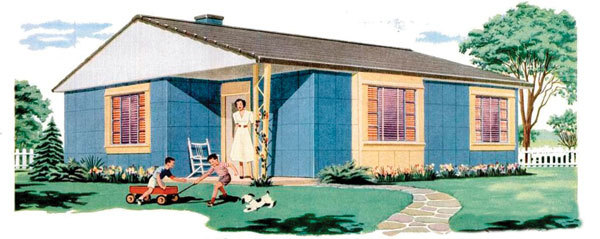
An advertisement illustration for Lustron Homes from the late 1940s.
Almost every day, by foot or car, I pass by a stretch of egg-colored Lustron houses with square steel exterior tiles in pale yellow, Robin’s egg blue, and dove grey. The porcelain enameled-steel readymade homes were a modernistic solution to the housing shortage many folks, especially GIs, faced after returning home after World War II. Carl Strandlund, a Swedish-born inventor and Chicago industrialist, created these “IKEA homes” and now, in 2019, around 1,500 of the Mid-Century Modern gems exist in the United States.
Less than 3,000 Lustron homes were manufactured between 1948-1950, with 15 of those houses still located in Brentwood, Missouri and 21 in Webster Groves, Missouri, two Saint Louis County suburbs. There are a few other Lustron homes sprinkled throughout the metropolitan area of St. Louis, but none as concentrated as the stretch of Litzsinger Road, the area I pass through almost daily.
History tells us that the reason for this concentration of all-steel homes is due in large part to Charles DeWitt Sr.’s Lustron company location, also located on Litzsinger. The quirky little homes that look like something a child could create with Legos were model homes that others went to view before selecting their own kit in the St. Louis area. Contractors who put these “Erector Set” homes together from 1948-1950 typically took three to five days to assemble a family home, some were as quick as a day!
Thinking about that speedy turn-around time makes me think about why we have not yet seen a home kit as beloved as the Lustron homes, many of which are on or starting to be listed on the National Trust for Historic Preservation. Moreover, it is remarkable that so many Lustron homes still exist or were in good enough shape to be disassembled and given a new life, like the homes that once had the largest concentration at Quantico Marine Base in northern Virginia). Of those homes in Quantico, rumor has it some even found their way to survivors of Hurricane Katrina.
So, where are the Lustron homes of today?
Granted, some people thought Lustron homes were the worst idea ever, but I have often thought how inventive and resourceful the homes were. Of course we have people who are priced out of housing markets, or who find themselves devastated by homeless-making natural disasters, and almost every day I read yet another story and compilation of statistics about why Millennials and younger generations are not buying homes. Surely, devising premanufactured homes with heart, substance, and style would be well-received if not more so than the Lustron homes of yore?
Dwell Magazine knows the score. They reported last summer that the vice-grip tightening of housing markets everywhere, especially in oversaturated places such as San Francisco, Seattle, and Toronto, is making the prefab life look more attractive and affordable to prospective homebuyers. In fact, Dwell even highlighted 10 prefab homes under $100,000 that make the sweet simplicity of Lustron homes look whimsical, if not painfully aware of how far we have come in designing kit homes since 1948.
While the “tiny house” trend has been brewing since the 2000s, I imagine we are overdue for much more excitement of what affordable architectural design can give people in overcrowded housing markets. While perhaps tornado-prone regions like the Middle West may be less keen to adopt prefab houses built on slab, other areas will surely experience a resurgence in the next wave of Lustron-evolved homes. It will be interesting to see if the prefab possibilities of 2019 will still be standing 70 years later like their all-steel counterparts.
